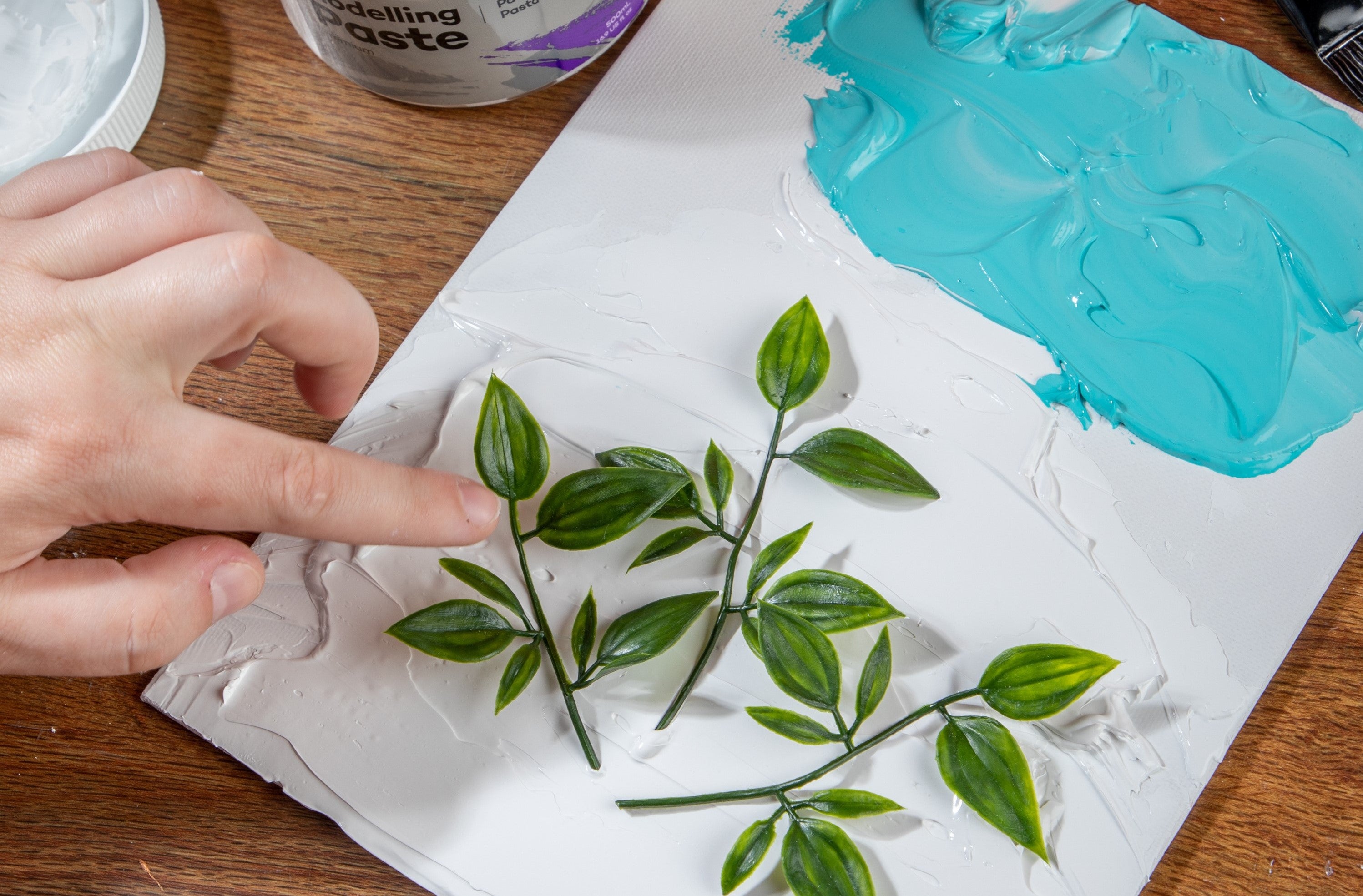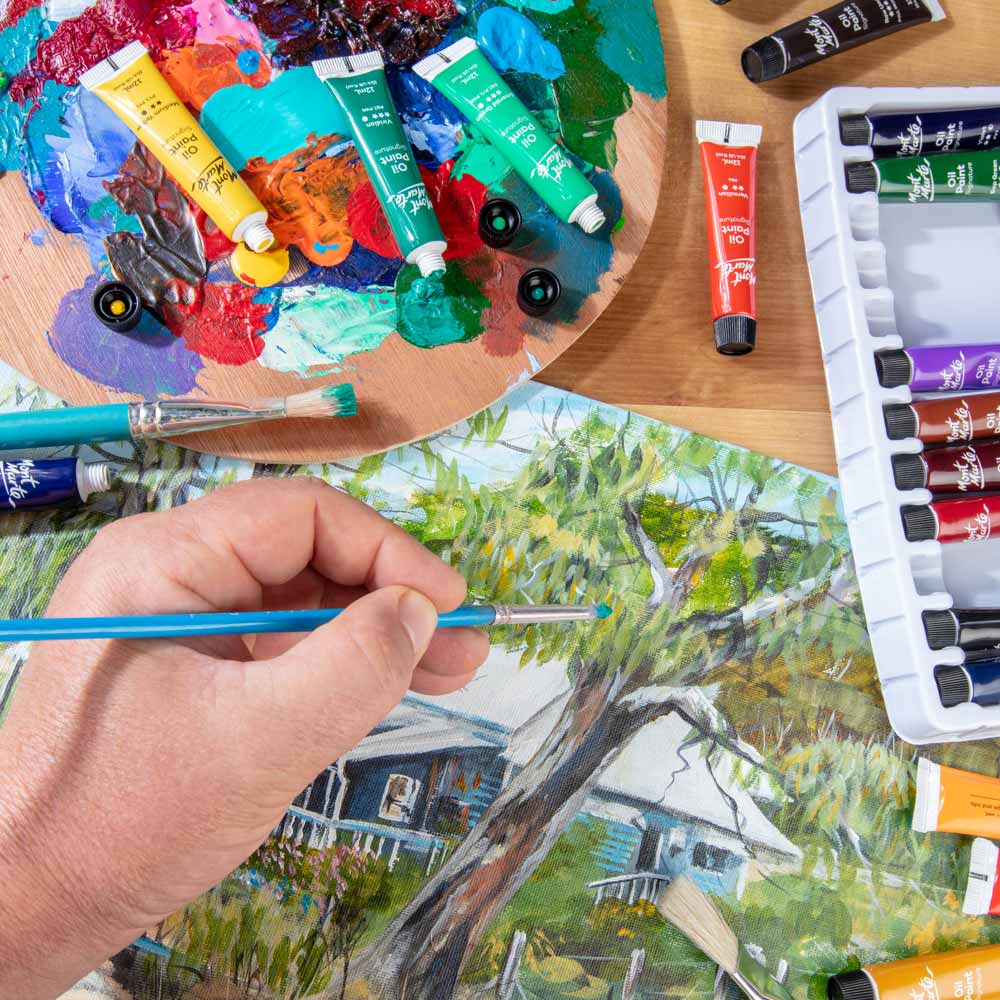If you’ve ever wondered how to create texture and imprint patterns when working on a project, we’re here to help! We’re going to dive into a bunch of different mediums and questions so you can tackle texture with confidence. Let’s get into it!
1. What is impasto?

Impasto texture is a technique where an art medium is layered or applied thickly so that it stands out from an art surface for a 3D effect. It’s great for building texture and dimension and adds extra depth to your work.
We also have Mont Marte Impasto, which is a medium you can mix with acrylic paints to make them thicker. This helps the paint stay firm and hold its shape as it dries, rather than levelling out and losing texture. It doesn’t affect the colour or opacity of the paint, so pick some up and experiment with adding defined brushstrokes to your next project.
2. How to add texture to acrylic paint?

Adding depth to a painting with acrylic paint is easier than it looks – just mix in one of our texture mediums or pick up some Dimension Acrylics and get creating! As we mentioned above, an easy way to add dimension is with the acrylic impasto painting technique. Mix in our Impasto with your acrylic paints for thicker paints that hold their shape when dry. Apply generously and layer the thickened paints for dynamic results that stand out from the canvas.
We also have a range of paints called Dimension Acrylic, that have a rich, thick formula. They hold their shape as they dry, ideal for defined strokes and buildability. They’re ready to go straight from the bottle or tub for quick texture results.
We also have Sand Texture Medium, which you can use to add coarse, grainy effects to your paintings. Mix it into your paints to change their consistency without affecting the colour tone. Try smearing 3D sandy paint onto your canvas for texture you can feel! You can also layer it beneath your paints for a coarse undercoat.
Lastly, Modelling Paste can be applied under paints or mixed with them for dynamic texture and dimension. If you apply it as an undercoat, make sure it dries completely before adding paint on top. If you mix it into your paints, be aware it’s an opaque white colour so it will create soft, pastel tones.
3. What are some quick ways to make clay texture?
Adding rough texture and imprinting designs into clay can be a great way to level up your creations. There are loads of clay tools you can use for texture by dragging over, poking into, moulding, or cutting your clay. You can press objects, stencils, and shapes into clay to stamp an outline, or use a textured roller to imprint designs.
Check out our Air Dry Clay Techniques and Polymer Clay Techniques articles for a few ideas on how to add texture to clay.
4. How do you create oil pastel texture?

Oil pastels are a great medium for creating easy texture in art. Our Extra Soft Oil Pastels have a buttery texture that makes adding impasto effects simple. There’s a few different techniques you can try for quick results.
1. Press firmly and twist the pastel while colouring for thick, 3D strokes. You can layer and build the impasto colours for dramatic depth.
2. Use a palette knife to cut off small pieces of oil pastel and use the flat side to smear it onto your paper. You can leave the pieces chunky or blend them smoothly for varied texture effects.
3. Heat up your oil pastels using a blow dryer, so they begin to melt at the tip. Stroke or smear the liquid pastel onto your paper, layering the colours to build dimension. The pastel will dry solid and stand out from the page!
5. How should I go about drawing texture?

For texture design drawing, there’s a few different techniques you can try. Dry media including pens, graphite, or charcoal applies flat and generally can’t be used for impasto texture. However, depending on how you work with the medium, you can create a visual impression of surface quality, rather than the physical texture itself.
Frottage is a simple technique you can use for rough texture drawing. Layer your paper over a textured surface and rub your chosen drawing medium over the top. The imprint of the texture will be captured, with shadows and highlights created depending on the state of the surface beneath the page.
Cross-hatching is a kind of shading where you overlap parallel lines to mimic a hatched effect. It has a rougher effect and is less blended than traditional shading. Cross-hatching is great for drawing natural textures like tree bark or rocks, but you can use it to add a coarse feeling to any subject matter.
Using negative space when sketching is vital to creating texture. The contrast between the exposed page and the shaded areas disrupts smooth colouring, breaking up blending and adding dimension to the page. You can add negative highlights back into your shading with the fine edge of a rubber for dynamic textures including fur and hair, finessing the movement and direction of your piece.
6. Is it possible to create watercolour texture?

There are loads of ways to add texture to watercolour, even though it’s a flat medium. We have a blog that covers a bunch of handy techniques you can try, but we’ll cover some of our favourites here.
1. Use a sponge to dab your watercolour. The texture of the sponge will show through on the page as it distributes watercolour organically. Layer up the effect for more depth and dimension.
2. Apply your watercolour and then drape plastic wrap over it while it’s still wet. The more folded or crinkled the wrap is, the more texture will be added. As it starts to dry, peel the wrap off to reveal the cool effect!
3. Use tools like Masking Fluid or a white crayon to block out negative space. The blocked areas will stay pristine as you layer colours on top, leaving crisp, highlighted areas in your final artwork. If you used Masking Fluid, peel it off once the watercolour layers have dried to reveal the negative space.
7. How do you change oil paint texture?

Oil paint is naturally thick, making it great for creating impasto brushstrokes. If you want to change the consistency for a smoother effect, try mixing in oil mediums. We have a range of mediums for oils that are designed to alter the flow of the paint, extending drying times and increasing their fluidity.
Our Refined Linseed Oil improves flow, slows down drying, and increases gloss; our Thickened Linseed Oil improves flow and reduces brushstroke retention for smooth blending, and our Safflower Oil increases the flow and transparency of oil paints, resisting yellowing.
8. How to use modelling paste to add dimension?

Modelling Paste is ideal for adding physical texture in art. Modelling paste can be applied as an undercoat for unique effects; spread it on thickly and use various tools to shape and mould the paste. You can roll, carve, or lift sections to alter the feeling of the surface, or even stick small objects into the paste while wet. Once the paste has dried, stuck objects will stay in place, and you can colour the undercoat with acrylic or oil paints.
Modelling paste can also be mixed with acrylic paint for thick, pastel paints. This is ideal for impasto brushstrokes and building depth.
If you’re feeling inspired, why not make a texture artwork at home? Explore dimensional patterns and designs for your next project.
If you do experiment with creating texture, #montmarteart or tag us @montmarteart on Instagram or Facebook. We want to see what you come up with!
To check out more answers to common art questions, browse our FAQs collection. For creative ideas, explore our Inspo and Projects and How-to blogs.
Stay up to date with the latest and greatest Mont Marte content by signing up to Creative Connection down below. You’ll get loads of free art projects, tips, and tricks sent straight to your inbox, free of charge.





































